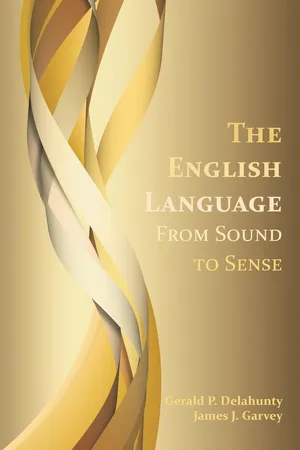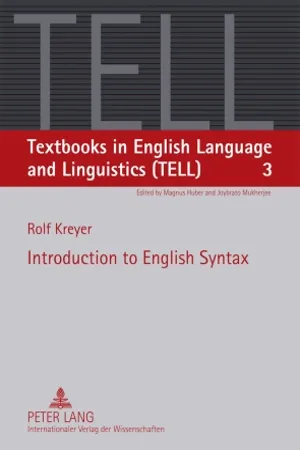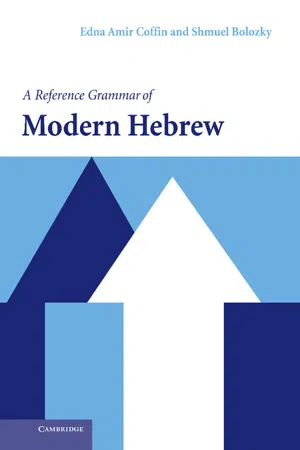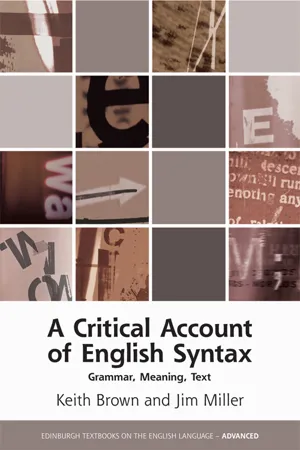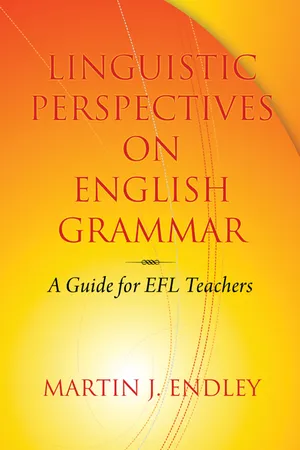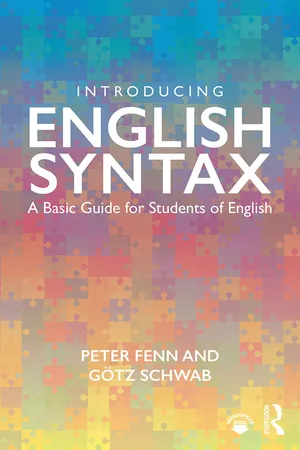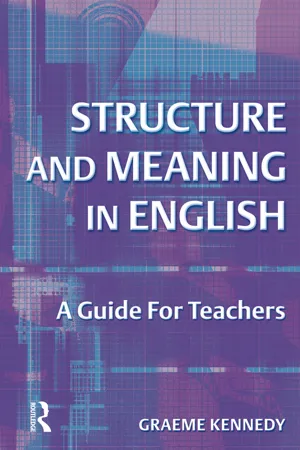Languages & Linguistics
Adjective Phrase
An adjective phrase is a group of words that functions as an adjective in a sentence. It consists of an adjective and any modifiers or complements that accompany it. Adjective phrases provide additional information about a noun or pronoun in a sentence, and they can be used to add detail and description to the subject.
Written by Perlego with AI-assistance
Related key terms
1 of 5
7 Key excerpts on "Adjective Phrase"
- eBook - PDF
English Language, The
From Sound to Sense
- Gerald P. Delahunty, James J. Garvey(Authors)
- 2010(Publication Date)
- Parlor Press, LLC(Publisher)
For example, in English (and many other languages), adjectives typically pre-cede the nouns they modify, whereas in Spanish (and many other languag-es), adjectives typically follow the nouns they modify. Language learners must learn the orders expected in the target language. Their teachers must know the ordering possibilities and be able to articulate them in ways their students can learn from. As we examine phrases, then, we study how words relate to each other in the smallest of the larger linguistic structures. In our chapters on Basic Delahunty and Garvey 274 Clause Patterns and Modifications of Basic Clause Patterns, we examine the ways in which phrases form clauses. Our discussion here will treat the five major phrase types in English: 1. Adverb Phrase (AdvP) 2. Prepositional Phrase (PP) 3. Adjective Phrase (AP) 4. Noun Phrase (NP) 5. Verb Phrase (VP) We will discuss each of the five types in a similar way. First, we will exam-ine their basic functional patterns; then how those functions are realized by structural possibilities; and, where appropriate, we will explore some of the complexities associated with each type of phrase. Whenever such complexi-ties lead us to topics considered in another chapter, we will provide a brief commentary and defer fuller treatment to a later time. WHAT IS A PHRASE ? Traditionally “phrase” is defined as “a group of words that does not contain a verb and its subject and is used as a single part of speech.” This definition entails three characteristics: (1) it specifies that only a group of words can constitute a phrase, implying that a single word cannot; (2) it distinguishes phrases from clauses; and (3) it requires that the groups of words believed to be a phrase constitute a single grammatical unit. We accept (2) and (3), but must revise (1). We reject the claim that single words cannot constitute phrases. - eBook - PDF
- Rolf Kreyer, Joybrato Mukherjee(Authors)
- 2012(Publication Date)
5 Adjective, Adverb and Prepositional Phrase The two previous chapters dealt with the most important phrases of the English language, the verb and the noun phrase. This chapter will give a short overview of the three remaining phrases, namely adjective, adverb and prepositional phrase. 5.1 The Adjective Phrase Like the noun phrase, the Adjective Phrase can be defined with regard to its head, i.e. an Adjective Phrase is a phrase the head of which is an adjective. The adjec- tive phrase is similar to the noun phrase in that it contains premodifiers and postmodifiers. It differs from the noun phrase in that it does not contain deter- miners. The basic structure of the Adjective Phrase, accordingly is 'premodifica- tion - head - postmodification', consider the examples under (1) (the head is in bold print): (1) a) more traditional (w1a-012:043) b) almost impossible (w2b-016:067) c) hugely unprofitable (w2b-016:048) d) very restricted (s1a-001:104) e) far more simple (s2a-034:050) f) bigger than that (s1a-001:054) g) aware of how they can work with the disabled stu- dent (s1a-001:110) h) uninterested in conquering and controlling Fiji (w1a-012:010) i) unlikely to appreciate the irony of their situation (w2e-008:002) j) much cheaper than anybody else (s1a-010:036) k) very surprised at their commitment (s1a-005:157) l) quite happy to send their daughter to a boys' school (s1a-012:223) m) far too late for tinkering with the environment (w2b-013:004) As can be seen, adjectives (in addition to occurring on their own) can be pre- modified, postmodified or both. Aarts and Aarts (1982: 67) point to two special classes of adjectives. The first are adjectives that never occur with a modifier. 90 Chapter 5 Examples are latter in the latter view (w2a-006:081) or former in the former chief of defence staff (s2a-019:022). Such adjectives only occur as noun-phrase premodifiers, i.e. in attributive but never in predicative function (see section 2.2.4). - eBook - PDF
- Edna Amir Coffin, Shmuel Bolozky(Authors)
- 2005(Publication Date)
- Cambridge University Press(Publisher)
Chapter 11 Noun phrases 11.1 Introduction to noun phrases 11.2 Noun phrase: noun + adjective 11.3 Comparative and superlative adjectives 11.4 Apposition noun phrases 11.5 Construct phrases 11.6 Phrases of possession 11.7 Phrases with demonstrative pronouns 11.8 Prepositional phrases 11 9 Numeral and quantifier phrases 11.10 Noun phrases with determiners 11.11 Gerunds and infinitives in noun phrases 11.1 Introduction to noun phrases A noun phrase consists of a single noun (indefinite or definite), which can have additional components modify it. A single noun can have an article added to it or a pronoun suffixed to it and remain a single word, or independent words can be added to it as modifiers. The noun itself is viewed as the head of the phrase. It is the central item in the phrase. The other added components expand the meaning of the head noun or particularize it. The additional components can be articles, adjectives, demonstrative pronouns, numerals, other modifying nouns, prepositions with pronouns, relative clauses, or gerunds and infinitives that function as nouns. The noun phrase can function as a subject, a nominal predicate, a direct or indirect object, or within larger constituents (e.g., within a prepositional phrase or a sentential adverb, etc.). Here are some illustrations of the most basic positions: Chapter 11: Noun phrases 253 Subject These dogs are old. . Predicate Shunra is a cute cat . . Direct object Where did you buy this dog ? ? Indirect object They went for a walk with their dogs. . 11.1.1 Indefinite noun phrases There is no indefinite article in Hebrew. Nouns that have no article are indefinite. Tell me, do you have (any) tickets for the show? , ? It is possible to add the number / ‘one’ to a singular noun, to indicate a similar notion to ‘one object/an object’. I only have one ticket . . There is only one restaurant in which he is willing to eat. - eBook - PDF
A Critical Account of English Syntax
Grammar, Meaning, Text
- Keith Brown, Jim Miller(Authors)
- 2016(Publication Date)
- Edinburgh University Press(Publisher)
19 Adjectives and Adjective Phrases ADJECTIVES AND Adjective PhraseS: INTRODUCTION An Adjective Phrase (AP) is one headed by an adjective, as in interesting ideas , people eager to help , (We’re) ready to leave . APs occur in attributive position, preceding the noun in an NP, as in the new proposal , some very attractive houses , those noisy crows . APs also occur in predicative position, functioning as the complement of verbs such as be , become , seem and appear : The children were sleepy , The sky became orange and red , The politicians seemed worried , She appeared unable to stand up . The adjectives in APs are said to be used, or to function, attributively or predicatively. There is a third position that can be occupied by APs, as shown in (1). 1 a Elegant and intelligent, Elizabeth had many admirers. b Worried about the interview, James came to ask our advice. c Pale and extremely thin, David could hardly walk. Analysts who like the concept of a verbless clause can treat the under-lined phrases in (1a–c) as clauses. One snag is that not only do these sequences have no verb but they have no subject either. Clauses without overt subjects are normally said to have resulted from ellipsis (=> CLAUSE STRUCTURE : VERB PHRASES . ) or to have an understood subject that is controlled by a noun phrase (NP) in another clause. ( => N ON - FINITE CLAUSES : INTRODUCTION .) The second snag is that clauses with understood subjects typically follow the clause containing the overt subject NP that permits the understood subject to be interpreted. In contrast, the underlined phrases in (1a–c) precede the clauses that contain the controlling subject. Analyses resting on ellipsis and/or con-trolling NPs turn out to be not straightforward, especially if thought of as a set of explicit procedures. An alternative analysis is to take the underlined phrases at face value, as APs, allow them to apply to the subject NP of the following clause, - eBook - PDF
- Martin J. Endley(Author)
- 2007(Publication Date)
- Information Age Publishing(Publisher)
Additionally, I will briefly touch upon two further potential difficulties in relation to ad- jectives, namely participles and compound forms. After this, I will turn to adverbs, limiting my discussion to two main issues: first, the similarities and differences between adjectives and adverbs; and second, the functions per- formed by adverbial expressions. The Adjective Word Class: Morphosyntactic Characteristics In some languages, the adjective class is a small, closed class. And some lan- guages lack such a class entirely, with the meanings expressed by adjectives in English being expressed by other syntactic categories. However, modern Adjectives and Adverbs in Linguistic Perspective 79 English has a rich range of adjectives and they are ubiquitous in the speech and writing of EUEs. Like nouns and verbs, adjectives belong in the open class of words in English and it is not uncommon for new adjectives to be added to the language. What, then, is an adjective? Students are often taught that an adjective is a word that “describes” or modifies a noun. This is a reasonable start- ing point, insofar as many adjectives are found in close association with nouns, but, once again, there is a great deal more that needs to be said. In fact, as we will see shortly, only some adjectives are modifiers. Others are better understood as complements. The use of such labels is not always a straightforward matter. For our purposes, we can say that a modifier is an optional element; on the other hand, a complement is grammatically required. The Position of Adjectives: The Prenominal Position In English, there are two main positions that an adjective may occupy in a construction. One position is within a noun phrase, immediately pre- ceding the noun. I will follow the conventional designations, referring to adjectives in the prenominal position as attributive adjectives, and adjectives in post-verbal position as predicative adjectives. - eBook - PDF
Introducing English Syntax
A Basic Guide for Students of English
- Peter Fenn, Götz Schwab(Authors)
- 2017(Publication Date)
- Routledge(Publisher)
4 Phrases and their structure (I) 4.0 Phrases As we saw in the last chapter, the phrase is the most basic unit in sentence analysis. It is a structural unit based on word-class, and is the smallest unit that can fill a sentence function. In this chapter we take a close look at what phrases consist of, i.e. what we will call here in a general sense their composition. Like sentences, phrases can be analysed internally in terms of both structures and functions. In other words, the composition of a phrase consists of phrase functions and the struc- tures that fill them. That is, like sentences, phrases can be analysed on the one hand structurally, and on the other hand functionally: (1) Composition of phrase Structures Functions What this means concretely we will see in the following. In this first chapter on the phrase, we will be looking at noun phrases, prepositional phrases, Adjective Phrases, and adverb phrases. 4.1 The noun phrase Let us look first of all at some typical structural patterns in the noun phrase: (2) a. noun alone trees b. article + noun the trees Phrases and their structure (I) 65 c. article + Adjective Phrase + noun the big trees d. article + Adjective Phrase + noun + prepositional phrase the big trees in our garden The minimum that we need in order to form a noun phrase is a single noun, as in (2)a. The rest is just a selection, of course. The prepositional phrase could follow the noun on its own (trees in our garden), for example, or the adjective could be used without the article (big trees). We´re simply looking here at the main pos- sibilities for combining structural elements within a noun phrase. As can be seen in (2)c. and (2)d., other types of phrase unit can also be included, here an adjec- tive phrase and a prepositional phrase. One phrase inside another one is a general phenomenon in syntax. The prepositional phrase itself here (in our garden), for instance, also contains a further noun phrase (our garden). - eBook - ePub
Structure and Meaning in English
A Guide for Teachers
- Graeme Kennedy(Author)
- 2014(Publication Date)
- Routledge(Publisher)
Chapter 6 Modification of noun phrases, verb phrases and sentencesThis chapter is designed to show how adjectives, adverbials and prepositions are used, and the difficulties that learners of English are faced with in using them.Objectives By the end of this chapter you should be able to:6.1 Adjectives- Identify adjectives.
- Explain the functions of adjectives.
- Identify the various forms of adjectives.
- Describe the positions adjectives are found in.
- Explain the functions of comparative and superlative adjective and adverb forms.
- Distinguish adjectives from participles.
- Identify adverbs and adverbials.
- Distinguish adjectives from adverbs.
- Describe the main structures that can be used as adverbials.
- Explain the main semantic functions of adverbials.
- Distinguish between adjuncts, subjuncts, disjuncts and conjuncts.
- Identify prepositions.
- Explain the main functions of prepositions and prepositional phrases.
- Know which prepositions are most frequently used.
- Distinguish between prepositional verbs and phrasal verbs.
We have already seen in Chapter 4 that determiners can modify nouns. Nouns can also be modified in other ways as part of noun phrases, e.g.1 a successful athlete2 an outstanding athlete3 an athlete from Spain4 an athlete who was successful in the Olympics5 an athlete known all over the worldThese five examples show that nouns can be modified by single words, phrases, or whole clauses. Some modifiers occur before the nouns they modify; others occur after. One of the classes of noun modifiers consists of single words called adjectives which associate certain characteristics such as colour, size or shape to nouns, e.g. a red car. This section describes the use of adjectives. The modification of nouns by phrases or clauses is described in Chapter 7
Index pages curate the most relevant extracts from our library of academic textbooks. They’ve been created using an in-house natural language model (NLM), each adding context and meaning to key research topics.
